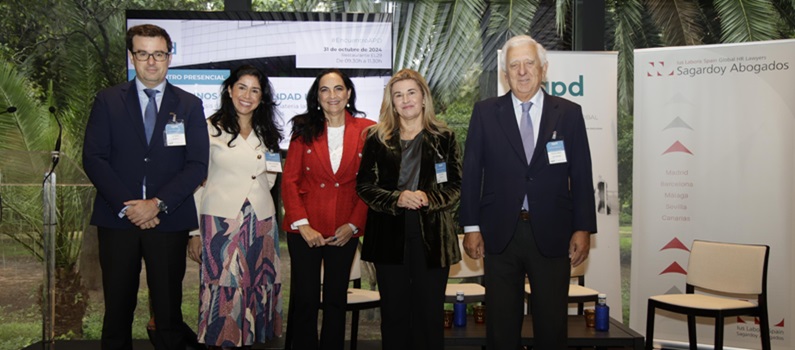The EY-Sagardoy Talent and Innovation Institute has today presented the 10th edition of the Human Capital Outlook at a venue belonging to the Madrid City Council. This quarterly report, prepared in collaboration with FEDEA, analyzes the evolution of the labor market in the second quarter of 2024.
The presentation of the Observatory was attended by Fátima Báñez, President of the EY-Sagardoy Talent and Innovation Institute; Íñigo Sagardoy, President of Sagardoy Abogados; Engracia Hidalgo, Delegate of the Government Area for Economy, Innovation, and Finance of the Madrid City Council; Antonio Sánchez, General Director of Human Resources Planning at the Madrid City Council; Martín Godino, Managing Partner of Sagardoy Abogados; Rafael Doménech, Head of Economic Analysis at BBVA Research; Fernando Íñiguez, Director of People Consulting at EY; and Juan Pablo Riesgo, Secretary of the Advisory Board of the EY-Sagardoy Institute.
The report from the Institute indicates that job creation is on the rise, while workplace absenteeism has doubled over the past 10 years, surpassing 6.5% of hours worked.
The EY-Sagardoy Institute’s Report highlights that job creation in the first quarter of 2024 was higher than that in the fourth quarter of 2023, driven by hiring in the private sector and focusing on the Spanish population under 25 years old and over 54, as well as the foreign population between 25 and 34 years old. Real productivity per worker declined despite the increase in GDP per hour worked. Indefinite contracts continued to grow in 2023, but there was a significant reduction in the conversion of temporary contracts to indefinite ones.

X Human Capital Outlook: Key Findings
The report highlights that job creation saw a significant increase in the first quarter of 2024. This growth was primarily driven by the private sector, with key demographic groups contributing to the creation of employment, including both young people, older individuals, and foreign workers.
The report also underscores the significant contribution of the foreign population to the growth of employment since the end of 2019. Additionally, the study points to a moderation in the growth of labor costs, driven by a control on the rise of social security contributions and increased labor productivity.

Quarterly Labor Market Observatory
In this new edition of the Human Capital Outlook, the Quarterly Labor Market Observatory, which constitutes the first section of the document, analyzes the evolution of the labor market based on the available data for the first quarter of 2024. It is divided into three parts.
The first part provides an overview of the evolution of the main aggregate indicators—employment, unemployment, and economic activity—highlighting the rebound in job creation and the moderation in the growth of labor costs, in a context of increasing productivity per hour worked.
In the second part of the report, the changes in the differences between the unemployment and employment indicators from administrative records and the EPA (Labor Force Survey) are analyzed, following their adaptation to the 2021 census. It is also observed that permanent contracts continued to grow in 2023, although there was a substantial reduction in the conversion of temporary contracts to permanent ones.
Finally, the third part focuses on the sectoral analysis of Spain’s chronic labor productivity deficit, which has worsened over the last decade, in comparison to the Economic and Monetary Union (EMU).

Labor Law Update
Among the regulatory developments highlighted in the latest edition of the Human Capital Outlook is the approval of Royal Decree-Law 2/2024, of May 21, which adopts urgent measures for the simplification and improvement of the unemployment protection level and to complete the transposition of Directive (EU) 2019/1158 of the European Parliament and the Council, dated June 20, 2019, concerning the reconciliation of family and professional life for parents and caregivers. It also repeals Directive 2010/18/EU of the Council. This new legislation not only modifies unemployment benefits and subsidies but also the non-contributory minimum vital income benefit, allowing, under certain conditions, the compatibility of the latter with the performance of an economic activity.
Furthermore, the consolidated text of the Statute of Public Employees, approved by Royal Legislative Decree 5/2015, of October 30, amends Royal Legislative Decree 2/2015, of October 23, which approves the consolidated text of the Workers’ Statute (ET), to incorporate the contents of the repealed Royal Decree-Law 7/2023, with certain changes regarding the concurrence of collective agreements.
Along with this Royal Decree-Law, other legislative developments, ministerial orders, and legislative projects are also included. The report further includes commentary on three current rulings with significant relevance in the context of labor law.

Trends in Human Capital
Regarding the Trends in Human Capital section, this edition addresses the challenge of workplace absenteeism in Spain, a country that reports a high rate of absenteeism compared to other European nations. This phenomenon directly impacts the productivity and competitiveness of the country and may create uncertainty among foreign investors.
The report discusses both external and internal factors influencing absenteeism, such as the macroeconomic situation, public health policies, labor and social regulations, as well as internal company aspects like remuneration and work-life balance policies. It also analyzes individual factors contributing to absenteeism, including the worker’s health, family responsibilities, and work pressure. The importance of creating a work environment that promotes the physical, mental, and emotional well-being of employees, as well as professional development and diversity in the workplace, is emphasized.
Note: Access the full report ‘X Human Capital Outlook’ (June 2024) by clicking the download button.


